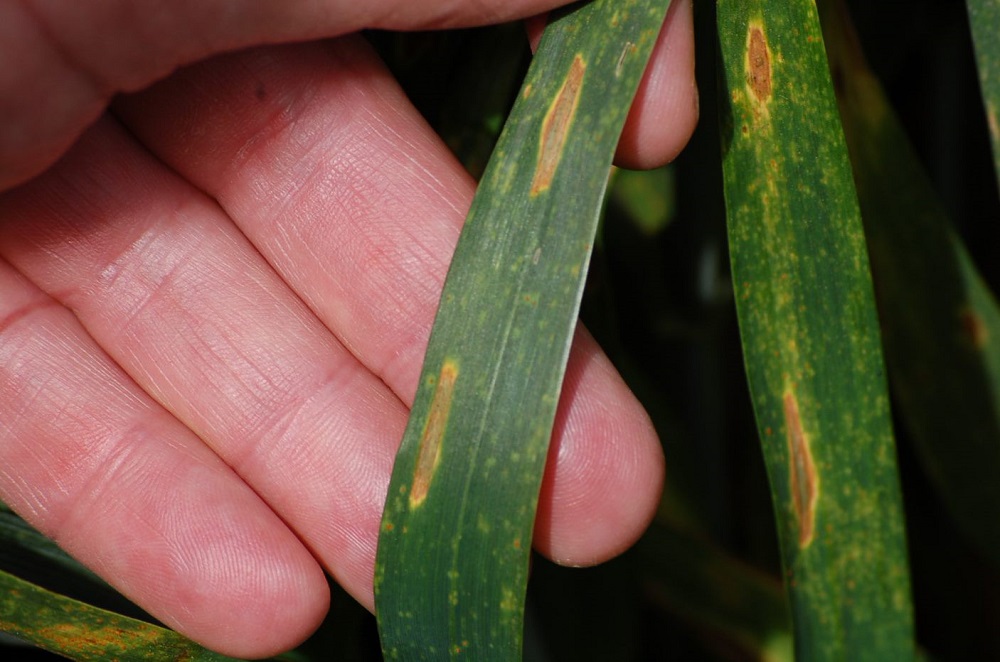Septoria tritici disease resistance in winter wheat
Friday, 2 July 2021
Some winter wheat varieties in our Recommended Lists (RL) trials appear to show higher levels of septoria than would be expected from the disease ratings published in the current RL (2021/22 edition). With disease assessments currently being undertaken by RL trial inspectors, Paul Gosling, who leads the RL at AHDB, takes a look at the emerging picture.
AHDB Recommended Lists home page
Septoria tritici in winter wheat
Grower needed to help recommend barley and oat varieties
In the last few weeks, disease has started to take hold on winter wheat crops. Our trial inspectors have observed that some soft wheat varieties have unexpectedly high levels of septoria tritici – certainly more than the current RL disease ratings would otherwise suggest.
Which varieties are affected?
Until the disease data has been validated, it is not easy to answer this question. Although, it does appear to affect varieties with one variety in common in their parentages in particular – Cougar.
However, across trials, there is tremendous variability. This will need to be statistically analysed before conclusions are reached.
As a precaution, growers should monitor disease levels on all varieties carefully.
| Variety | UKFM Group | 2021/22 rating | Parentage |
| LG Prince (UK)* | 3 | 7.1 | (Cougar x KWS Kielder) x Revelation |
| LG Illuminate (UK)* | 3 | 7.0 | (Cougar x Leeds) x Britannia |
| LG Quasar (UK)* | 3 | 6.6 | (KWS Croft x KWS Kielder) x Cougar |
| KWS Firefly (UK) | 3 | 6.8 | Cougar x KWS Rowan |
| Merit (E)* | 3 | 6.6 | Britannia x Cougar |
| LG Astronomer (UK)* | 3 | 7.4 | (Cougar x Leeds) x Britannia |
| RGT Saki (UK) | 4 (soft) | 6.5 | Cougar x KWS Santiago |
| Swallow (N)* | 4 (soft) | 5.7 | KWS Gator x Cougar |
The table (above) indicates RL varieties with Cougar in their parentages. *New to the RL 2021/22.
Resistance research
Cougar was added to the RL in 2013, with a septoria tritici disease resistance rating of 7. It stood apart from the majority of varieties that had moderate levels of resistance (ratings of 5 or 6). It showed consistently high levels of resistance until 2015, when moderate levels of disease were observed. The variety was removed from the RL in the 2016/17 edition.
The results of an AHDB-funded investigation, published in 2019, concluded that the loss of resistance, at that time, was limited to Cougar, with no other varieties affected. The work was based on genetic and phenotypic analyses of septoria tritici isolates collected from the field in 2015. Fungicide sensitivity screens on the isolates, conducted as part of the research, found no unexpected mutations associated with a loss of fungicide efficacy.
Read the cougar septoria report
What are the next steps?
Varietal resistance is key to the management of septoria tritici. Most varieties on the RL have multi-gene resistance to this disease. This means it is difficult to breed varieties with complete resistance (rating of 9), but it does mean that the resistance is durable and less likely to break down rapidly if the pathogen population changes (as happens with yellow rust).
However, it does appear that some key gene(s) associated with Cougar are vulnerable to being defeated by the pathogen.
Until all the 2021/22 trial data has been collected and validated, we will not know if all the varieties are affected to the same degree, including how far ratings will fall. However, it is highly likely that there will be differences.
We also do not know how widespread the issue is – however, higher-than-expected septoria levels have been seen in trials in the South, the West and on Teesside, so it is likely to be widespread.
After the relevant data has been collected, analysed and validated, AHDB will make the results public.
Video
Watch Mark Bollebakker, RL Senior Field Trials Manager, discuss the latest developments in the septoria story.
Topics:
Sectors:
Tags:



